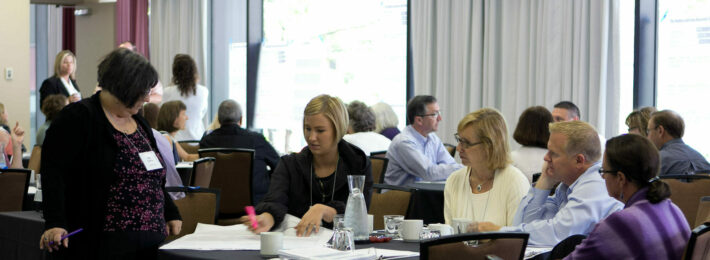
While working to design our conference Budgeting for Innovation in San Antonio, TX, we became fascinated by the Business Model Canvas, an open-source tool developed by Alex Osterwalder, Yves Pigneur, and others, which helps organizations swiftly explore alternatives, challenge assumptions, compare and set new strategies, and build shared vision and language. This tool helps institutions document their existing business model visually (including key partners, key activities, value proposition, customer segment, costs and revenues, etc.), rendering the invisible visible, and can be used to quickly identify opportunities to refine the cost structure or generate new revenues. It is the “how” in budgeting for innovation.
During our research, we had the opportunity to speak with a number of institutions that have used a Business Model Canvas to identify opportunities for innovation and to help budget for innovation. One of those institutions is Ocean County College, and we would like to share this interview we conducted with Sara Winchester, the institution’s executive vice president of finance and administration, which describes what OCC achieved and what advice they might have for other institutions. You can also see the Business Model Canvas in action at the post-conference workshop at the Budgeting for Innovation conference.
An Interview with Sara Winchester, Ocean County College
Academic Impressions. Hi Sara, thank you for this interview. Our first question is: What challenges did your use of a Business Model Canvas help address?
Sara Winchester.
Facing declining enrollment
The biggest challenge we were facing was enrollment decline. Enrollment at Ocean County College peaked in FY10 and, like most community colleges nation-wide, had been trending downward ever since. Local demographics showed continuing decline in the youth population and with a greater than 30% yield rate from local high schools, OCC needed to find a way to serve students outside the borders of Ocean County. Rather than accept a shrinking institution, with guidance from Dr. Donald Norris of Strategic Initiatives, OCC decided to use Business Model Innovation to reinvent OCC’s mission and launch or expand a range of new revenue streams and programs.
Expanding programs – and marketing
Traditionally OCC offered on campus courses with a smattering of distance learning offerings. Through Business Model Innovation, we were able to determine that substantial growth was possible if the e-Learning Division was expanded and full degree programs using master courses were developed. For the first time, OCC invested in marketing outside the borders of Ocean County and a slow but steady increase in out of county enrollment began. In addition, we developed partnerships that allow other NJ community colleges to rebrand and use OCC’s master courses, an entirely new revenue stream for OCC. We also reached out globally, allowing OCC to develop a partnership with Ain Shams University in Cairo, Egypt where students are enrolled in on-line OCC programs today.
Academic Impressions. What were the immediate takeaways? What longer-term outcomes do you foresee?
Sara Winchester.
Implementing new programs more quickly and reliably
“OCC has become both more decisive and nimble. Now that the Business Model Canvas is used to access the financial viability of a program or idea up front, we can move to implementation quickly.”
New, more current academic programs were developed for on-campus learners. Each program proposal was put through the Business Model Canvas and programs that were not financially feasible, such as Physical Therapy, were rejected. Other programs such as Fire Science were fast-tracked and implemented with little investment other than faculty time.
Expanding K-12 partnerships
Another immediate result is enhanced relationships with K-12 school districts. The Business Model Canvas helped us see that we should focus on outreach to K-12 to capitalize on interest in avoiding college debt. One way to avoid debt is to earn college credit while in still high school. An investment in staff who visit the schools regularly specifically to talk about this topic has resulted in an increase in enrollment in Jump Start and Early College Programs as well as the development of several new high school academy programs. Today, a new building is under construction to house the Ocean County Vocational Technical School Performing Arts Academy (PAA) on campus. PAA students will earn college credit and have the opportunity to graduate high school with an Associate’s degree, a win-win arrangement for all parties.
What’s next for us
Looking to the future, a long-term project in the pipeline is an on-line platform to support lesson plan development and teacher professional development for K-12 teachers. This is a transformational business model involving a partnership between OCC, NJ school districts and a private company, PLS 3rd Learning. The Business Model Canvas helped OCC realize that although the project does not fit into the traditional mission of the community college, intensive collaboration with K-12 will bolster the pipeline of students coming to OCC while providing immediate financial benefits to the College.
Academic Impressions. What advice would you give to other institutions that are trying to effectively budget for innovation?
Sara Winchester. I would say start with your strategic plan. Your strategic plan has to set the institution on the path to innovation and the budget will follow.
“It is much easier to fund a few sound, fully vetted ideas than to spend time on programs that would have been dismissed early on through the Business Model Canvas.”
Also innovation must be fully embraced by the President and the executive leadership team. The message that OCC was actively seeking new revenue streams was fully communicated within the college and some of the biggest breakthroughs were brought to the table by employees. For instance, employees who had existing professional relationships with individuals at Ain Shams University in Cairo, were the impetus for the partnership that now allows OCC to enroll students who reside in Egypt. In the past, such innovative ideas may not have been presented to the leadership team for consideration.
In FY17 the tide turned at Ocean County College and enrollment has begun to grow again. Ocean County College successfully used the Business Model Canvas (BMC) to discover new revenue streams that aligned with the competitive market and are helping us achieve financial sustainability.
Academic Impressions. Thank you, Sara! We appreciate you sharing the story of how OCC has been able to turn things around and move forward. We look forward to seeing the work you do over the next couples of years!


